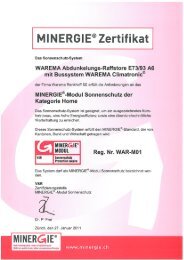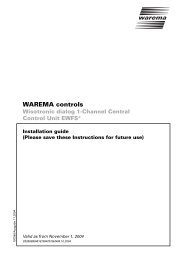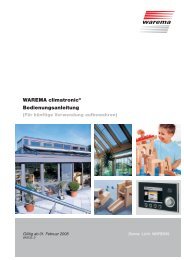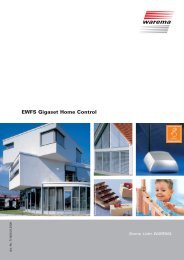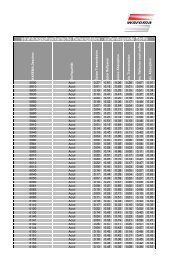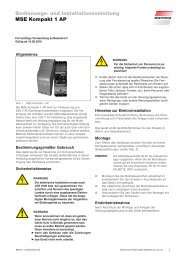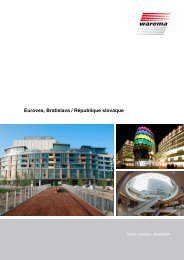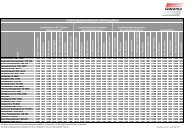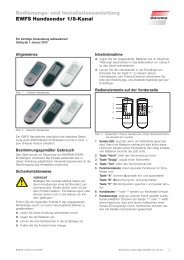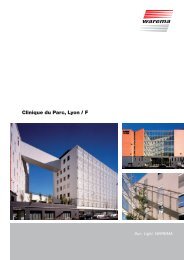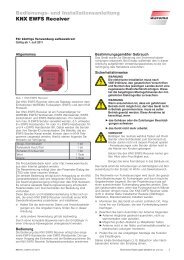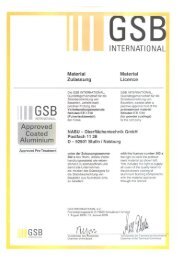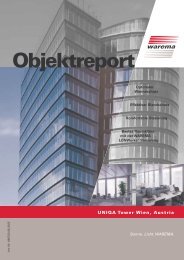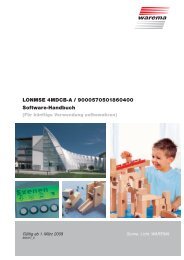Installation guide Wisotronic dialog 2/3-Channel CCU - Warema
Installation guide Wisotronic dialog 2/3-Channel CCU - Warema
Installation guide Wisotronic dialog 2/3-Channel CCU - Warema
You also want an ePaper? Increase the reach of your titles
YUMPU automatically turns print PDFs into web optimized ePapers that Google loves.
7983k0/Ausgabe 11/2004<br />
WAREMA Controls<br />
<strong>Wisotronic</strong> <strong>dialog</strong> 2/3-channel Central<br />
Control Unit EWFS ®<br />
<strong>Installation</strong> <strong>guide</strong><br />
(Please save these instructions for future use)<br />
Valid as from November 1, 2004<br />
93280690•816756•7983k0•08.10.2004
General Remarks<br />
General Remarks<br />
The publication of this manual<br />
supercedes all previous corresponding<br />
documentation.<br />
We reserve the right to make<br />
alterations in the interests of technical<br />
progress.<br />
Considerable care was taken in<br />
producing the text and graphics in this<br />
documentation but it is impossible to<br />
rule out errors completely.<br />
WAREMA provides you with a<br />
complete range of sun protection<br />
systems for windows, facades and<br />
glazed structures. Please contact the<br />
export department if you need any<br />
documentation on:<br />
– sun protection control systems<br />
– outside venetian blinds<br />
– inside venetian blinds<br />
– roller shutters<br />
– facade awnings<br />
– vertical awnings<br />
– markisolettes<br />
– conservatory awnings<br />
– articulated arm awnings<br />
– cassette awnings<br />
– basket awnings<br />
– Dutch canopy awning<br />
– insect screens<br />
– sun protections for roof windows<br />
– vertical louvre blinds<br />
– pleated blinds<br />
– roller blinds<br />
– black-out systems<br />
Safety Instructions<br />
Electrical installation work must be left<br />
strictly to qualified electricians. Only<br />
then is there any guarantee that your<br />
country´s statutory regulations are<br />
complied with and that the installation<br />
provisions of your local power supply<br />
company are properly observed. The<br />
user may be placed at serious risk if<br />
the equipment is wrongly installed.<br />
For further information please refer the<br />
the available user and installation<br />
<strong>guide</strong>s.<br />
Imprint<br />
WAREMA Renkhoff SE<br />
Hans-Wilhelm-Renkhoff Strasse 2<br />
D-97828 Marktheidenfeld/Main<br />
2<br />
Headquarter<br />
WAREMA Renkhoff SE<br />
Hans-Wilhelm-Renkhoff Strasse 2<br />
D-97828 Marktheidenfeld/Main<br />
P.o. box 13 55<br />
D-97822 Marktheidenfeld/Main<br />
Phone:+49 (0) 9391/20-0<br />
Fax: +49 (0) 9391/20-4299<br />
http://www.warema.com<br />
Sales Department (Sun protection<br />
control systems):<br />
Phone:+49 (0) 9391/20-3730;<br />
Fax: +49 (0) 9391/20-3739<br />
Application technique:<br />
Phone:+49 (0) 9391/20-6720;<br />
Fax: +49 (0) 9391/20-6729<br />
Service:<br />
Phone:+49 (0) 9391/20-6760;<br />
Fax: +49 (0) 9391/20-6769<br />
WAREMA and the WAREMA logo are trademarks of WAREMA Renkhoff SE.<br />
All other brand names or product names mentioned in this documentation are<br />
trade marks or registered trade marks of their respective owners.<br />
© 2004, WAREMA Renkhoff SE<br />
93280690•816756•7983k0•08.10.2004
Table of contents<br />
1. General ................................................................................................................. 5<br />
2. For your safety ..................................................................................................... 6<br />
2.1 Pictogram and symbol explanations ................................................................ 6<br />
2.2 Usage to the intended purpose ....................................................................... 8<br />
2.3 Target group ..................................................................................................... 8<br />
2.4 Working safely ................................................................................................. 9<br />
2.5 Software version.............................................................................................. 9<br />
3. Mounting ............................................................................................................. 10<br />
3.1 Procedure ...................................................................................................... 10<br />
3.2 Mounting the power unit ............................................................................... 11<br />
3.2.1 DIN rail-mounted variant .......................................................................... 11<br />
3.2.2 Surface-type housing variant .................................................................... 12<br />
3.2.3 Flush-type housing variant ....................................................................... 13<br />
3.3 "Wind/Photo/Radio clock" sensor ................................................................... 14<br />
3.3.1 Allocation/alignment of the photo diodes................................................. 15<br />
3.3.2 Radio clock reception ............................................................................... 15<br />
3.4 "Photo/Radio clock" sensor ............................................................................ 17<br />
3.5 "Photo" (180°) sensor ..................................................................................... 17<br />
3.6 "Rain" (capacitive) sensor .............................................................................. 18<br />
3.7 "Temperature" (outside) sensor ...................................................................... 19<br />
3.8 "Temperature" (inside) sensor 5 to 40°C ........................................................ 19<br />
3.9 "Temperature" (inside) sensor -25 to +75°C ................................................... 19<br />
3.10 "Temperature/Humidity" (inside) sensor ......................................................... 20<br />
3.11 Connecting sensors ....................................................................................... 20<br />
4. Connection information .................................................................................... 21<br />
4.1 Handling of the screwed terminals of the power unit (DIN rail-variant) ......... 22<br />
5. Wiring diagrams .................................................................................................. 23<br />
5.1 "Wind/Photo/Radio clock" sensor ................................................................... 24<br />
5.2 "Photo/Radio clock" sensor ............................................................................ 25<br />
5.3 "Photo" (180°) sensor ..................................................................................... 26<br />
5.4 "Rain" (capacitive) sensor ............................................................................... 27<br />
5.5 "Temperature" (outside) sensor ...................................................................... 28<br />
5.6 "Temperature" (inside) sensor 5 to 40°C ........................................................ 29<br />
5.7 "Temperature" (inside) sensor -25 to +75°C .................................................. 30<br />
5.8 "Temperature /humidity" (inside) sensor ....................................................... 31<br />
5.9 External channel buttons / external master switch ........................................ 32<br />
5.10 Control cables ................................................................................................ 33<br />
5.11 Alarm contact and lock switches ................................................................... 34<br />
5.12 Connecting single drives................................................................................ 35<br />
6. Mounting the control panel ............................................................................. 36<br />
6.1 Handling of the spring-load terminals of the control panel ............................ 36<br />
6.2 Connecting the control panel ......................................................................... 37<br />
6.3 Removing the control panel ........................................................................... 38<br />
7. Commissioning ................................................................................................... 39<br />
7.1 Automatic presetting ..................................................................................... 39<br />
7.1.1 Password ................................................................................................. 39<br />
7.2 Changing the user language .......................................................................... 40<br />
7.3 Setting the product type ................................................................................ 41<br />
7.4 Activating the lock switches .......................................................................... 42<br />
7.4.1 Checking interlocking ............................................................................... 42<br />
7.5 Setting the time and date .............................................................................. 43<br />
7.6 Allocating connected sensors ........................................................................ 45<br />
93280690•816756•7983k0•08.10.2004 We reserve the right to carry out improvements 3
Table of contents<br />
4<br />
Technische Änderungen behalten wir uns vor<br />
8. Factory settings................................................................................................... 47<br />
9. Custom settings .................................................................................................. 49<br />
10. Technical data .................................................................................................... 51<br />
11. User information ............................................................................................... 53<br />
12. Notes .................................................................................................................. 54<br />
93280690•816756•7983k00•08.10.2004
<strong>Wisotronic</strong> <strong>dialog</strong> 2/3-channel Control Unit<br />
EWFS ®<br />
1. General<br />
With the <strong>Wisotronic</strong> <strong>dialog</strong> you now own a multifunctional sun protection control<br />
unit which can control various sun protection products (slat products, cloth<br />
products, roller shutters, window drives, etc.) intelligently in accordance with the<br />
respective weather conditions. The <strong>Wisotronic</strong> <strong>dialog</strong> is available in 2 basic<br />
variants:<br />
® 2-channel module<br />
® 3-channel module<br />
The control panel and power unit can be mounted separately and only have to be<br />
connected by means of a 4-wire line. Drives, sensors, lock switches, and<br />
pushbuttons are connected to the power unit. Various modules of the power unit<br />
are available to suit the respective control panel:<br />
® As a REG / DIN rail-mounted device (REG, 12 modular spacings)<br />
® In a flush-type housing<br />
® In a surface-type housing<br />
You can either operate your sun protection products manually or leave the<br />
operation completely to the automatic control products. The <strong>Wisotronic</strong> <strong>dialog</strong><br />
protects your sun protection against harmful weather influences and offers extensive<br />
comfort and safety functions. The <strong>Wisotronic</strong> <strong>dialog</strong> can furthermore be<br />
operated via an EWFS radio remote control unit (1 or 8 channels), whereby the<br />
radio receiver is integrated in the control panel.<br />
The <strong>Wisotronic</strong> <strong>dialog</strong> evaluates the data for:<br />
® Wind,<br />
® Rain,<br />
® Brightness,<br />
® Internal and external temperature,<br />
® Relative humidity<br />
® Time (DCF-77 reception)<br />
and correspondingly controls the connected sun protection products, such as slat<br />
products (outside venetian blinds, internal venetian blinds), cloth products<br />
(awnings, pleated blinds), vertical venetian blinds, darkening units, roller shutter<br />
and window drives.<br />
93280690•816756•7983k0•08.10.2004 We reserve the right to carry out improvements 5
<strong>Wisotronic</strong> <strong>dialog</strong> 2/3-channel Control Unit<br />
EWFS ®<br />
2. For your safety<br />
2.1 Pictogram and symbol<br />
explanations<br />
6<br />
We reserve the right to carry out improvements<br />
We have developed, manufactured and tested the control system under<br />
observance of the fundamental safety requirements.<br />
Residual risks nevertheless remain!<br />
■ Therefore read these instructions before you install the control system.<br />
■ Please save these instructions for future use!<br />
The following warnings and notes which are intended to draw your attention to<br />
certain points can be applied to the control system itself or to the connected<br />
devices:<br />
Warning against dangerous electrical voltage!<br />
Electrostatic sensitive devices!<br />
Only for connection of the protective earth (PE) conductor!<br />
Only for connection of a shielded conductor!<br />
93280690•816756•7983k0•08.10.2004
<strong>Wisotronic</strong> <strong>dialog</strong> 2/3-channel Control Unit<br />
EWFS ®<br />
Hierarchic warnings are used in these instructions.<br />
They are identified by a warning sign in the margin and graded hierarchically as<br />
follows:<br />
1. WARNING<br />
2. ATTENTION<br />
3. CAUTION<br />
WARNING<br />
ATTENTION<br />
CAUTION<br />
The term WARNING is used as a warning against immediate<br />
imminent danger.<br />
Death or serious injuries may result (damage to persons)<br />
The term ATTENTION is used as a warning against a possible<br />
imminent danger.<br />
Death, serious or minor injuries (damage to persons), damage to<br />
property or damage to the environment may result.<br />
The term CAUTION is used as an application<br />
recommendation.<br />
Damage to property may result from non-observance.<br />
In addition to the hierarchic warnings described above we use the following<br />
symbols:<br />
TIP<br />
■ This sign identifies<br />
This is used to mark text sections which contain additional<br />
explanations, information or hints.<br />
- Activities which you must carry out, or<br />
- Instructions which must be observed.<br />
93280690•816756•7983k0•08.10.2004 We reserve the right to carry out improvements 7
<strong>Wisotronic</strong> <strong>dialog</strong> 2/3-channel Control Unit<br />
EWFS ®<br />
2.2 Usage to the intended<br />
purpose<br />
2.3 Target group<br />
8<br />
We reserve the right to carry out improvements<br />
ATTENTION<br />
ATTENTION<br />
ATTENTION<br />
The control system allows the direct connection of a<br />
conventional sun protection drive per channel. Alternatively<br />
several sun protection drives can be connected together via<br />
motor control units. Should you have any questions about<br />
connecting non-sun-protection devices, please obtain the<br />
approval of the manufacturer! The equipment is intended for<br />
the assembly in interiors.<br />
When window drives are used, the installer of the system<br />
must ensure that the safety requirements and regulations of<br />
DIN EN 60335-2-103 "Special requirements for drives of gates,<br />
doors and windows” as well as of ZH 1/494 "Guideline for<br />
power-driven windows, doors and gates" are observed.<br />
The approval of the manufacturer has to be obtained if the<br />
device is to be used to a purpose different to that described<br />
here. Usage which is not to the intended purpose can result in<br />
damage to the user or third parties as well as damage to the<br />
device itself, the connected devices or to the moving<br />
mechanical parts of the complete system.<br />
■ Therefore always use our product to the intended purpose only!<br />
These instructions are intended for persons who mount, wire or connect the<br />
<strong>Wisotronic</strong> <strong>dialog</strong> including all the required parts to the supply voltage. The user<br />
instructions (Art. No. 816755) are available for those persons who operate, set or<br />
commission the control system.<br />
ATTENTION<br />
Mounting, connection, commissioning or operation by<br />
persons who are not sufficiently qualified and informed can<br />
cause severe damage to the system or even damage to<br />
persons!<br />
■ Mounting and commissioning may therefore only be carried out by<br />
correspondingly trained specialists! This personnel must be able to recognize<br />
dangers which can be caused by the mechanical, electrical or electronic<br />
equipment!<br />
■ Persons who mount or connect the <strong>Wisotronic</strong> <strong>dialog</strong> must know and have<br />
understood the contents of these instructions.<br />
■ The <strong>Wisotronic</strong> <strong>dialog</strong> has been designed and constructed by us to be safe. All<br />
the necessary settings are carried out during the commissioning process. The<br />
system parameters only need to be modified if the behavior of the control<br />
system is to be adapted, a change has occurred at the sensor equipment or<br />
the <strong>Wisotronic</strong> <strong>dialog</strong> itself is replaced.<br />
ATTENTION<br />
States of danger, malfunctions and material damage to the<br />
system possible due to improperly executed mounting,<br />
connection, repair or maintenance work!<br />
■ Such work may only be carried out by the service department or by authorized<br />
qualified personnel!<br />
■ When carrying out maintenance or repair work only use such spare/<br />
replacement parts which are authorized by the system manufacturer.<br />
93280690•816756•7983k0•08.10.2004
<strong>Wisotronic</strong> <strong>dialog</strong> 2/3-channel Control Unit<br />
EWFS ®<br />
2.4 Working safely<br />
2.5 Software version<br />
WARNING<br />
States of danger, malfunctions and material damage to the<br />
system due to the disconnection of connections during<br />
operation are possible!<br />
All the connections are required to ensure correct operation of<br />
the control system.<br />
■ Therefore always switch off the entire system before you connect or<br />
disconnect connecting lines.<br />
ATTENTION<br />
Danger to life and damage to property through sudden<br />
movements of mechanical units!<br />
■ If you want to carry out work at motor-driven windows or at building facades<br />
at which motor-driven sunblinds are installed, switch off the sun protection<br />
system beforehand! Ensure that the system is secured sufficiently against<br />
unauthorized or unintentional activation.<br />
■ Ensure that suitable systems for protecting persons are used under all<br />
circumstances.<br />
■ Never place any objects in the area of movement of an automatically<br />
controlled mechanism (for example a ladder against a wall with articulated arm<br />
awning)!<br />
The following documents are available in addition to these instructions:<br />
® User <strong>guide</strong> Art. No.: 816755<br />
® Anschlusspläne für MSE, Netzteile und GA Art. 816 345 (German)<br />
These instructions were drawn up on the basis of the software version<br />
CP 1954111x<br />
PU 1771111x<br />
Please refer to Section 9 of the user <strong>guide</strong> for further information about<br />
establishing the software version of your device.<br />
93280690•816756•7983k0•08.10.2004 We reserve the right to carry out improvements 9
<strong>Wisotronic</strong> <strong>dialog</strong> 2/3-channel Control Unit<br />
EWFS ®<br />
3. Mounting<br />
3.1 Procedure<br />
10<br />
We reserve the right to carry out improvements<br />
CAUTION<br />
States of danger and malfunctions possible!<br />
The <strong>Wisotronic</strong> <strong>dialog</strong> and its supplementary components<br />
may only be operated in a built-in state or at the specified<br />
mounting sites. If this is not observed, malfunctions or states<br />
of danger at the system are possible. Any claims to warranty<br />
or guarantee are definitely lost.<br />
Carry out the following points in the specified order:<br />
■ First specify at which points the individual components are to be mounted.<br />
Use the specifications in this section and in the data sheets of the sensors to<br />
this purpose.<br />
■ Then determine which cables are required to interconnect the components.<br />
Use the "Wiring diagrams" section to this purpose.<br />
■ Lay the required cables. Do not use cables with larger cross-sections than<br />
specified. It is best to use conduits to lay the motor cables.<br />
■ Mount and wire the individual components.<br />
■ Check the wiring before you switch on the supply voltage of the control<br />
system.<br />
■ Then carry out commissioning. Only then is the control system ready for use.<br />
The steps required for commissioning are described in detail in the "User<br />
<strong>guide</strong>" manual. Please refer to it.<br />
■ Check the correct direction of movement of the sunblind by operating the "Up"<br />
and "Down" buttons at the control system.<br />
Check the correct function of the connected sensors<br />
■ Check the measured value display of the temperature, humidity and<br />
brightness for plausible values.<br />
■ Check whether the wind speed display changes when the wind vane is<br />
turned.<br />
■ Activate the rain control (if sensor connected) and check whether the control<br />
system reacts to rain (wet the sensor area with water).<br />
■ Then adapt the behavior of the system to the ambient conditions and for<br />
special requirements. Also use the "User <strong>guide</strong>" to this purpose. Chapter 9<br />
furthermore contains a table with all the available setting steps (parameters),<br />
their limits and the factory settings.<br />
■ If you have changed the factory settings, record the new values of the system<br />
in the table (Chapter 9) after you have completed all the work.<br />
ATTENTION<br />
Mount electrical devices so that they can be accessed easily!<br />
(VDE 0100)<br />
93280690•816756•7983k0•08.10.2004
<strong>Wisotronic</strong> <strong>dialog</strong> 2/3-channel Control Unit<br />
EWFS ®<br />
3.2 Mounting the power unit<br />
3.2.1 DIN rail-mounted variant<br />
The power unit of the <strong>Wisotronic</strong> <strong>dialog</strong> is available in three variants: As a DIN railmounted<br />
variant, in a surface-type housing and in a flush-type housing. The device<br />
is to be mounted in a dry and easily accessible place. Under no circumstances<br />
may it be mounted outdoors nor may it be subjected to direct sunshine.<br />
ATTENTION<br />
TIP<br />
ATTENTION<br />
A disconnecting device is to be provided in the fixed<br />
installation in order to disconnect the power unit of the<br />
<strong>Wisotronic</strong> <strong>dialog</strong> from the supply voltage (power breaker<br />
conforming to EN 60335-1, Section 25.3, for example,<br />
miniature circuit-breaker).<br />
The power unit of the <strong>Wisotronic</strong> <strong>dialog</strong> has to be protected<br />
separately against short circuits by means of a circuit-breaker<br />
with a separate power cable. Any associated motor control<br />
units (MCU) and their consumers may not be protected<br />
against short circuits by means of this miniature circuitbreaker.<br />
Please observe the cable types recommended in the wiring<br />
diagrams.<br />
When mounted in a distribution board installation the device<br />
has to be mounted on a symmetrical DIN rail (35 mm to DIN<br />
EN 50022).<br />
The minimum distance between the supply terminals and<br />
another object has to amount to at least 10 mm at the<br />
DIN rail-variant. If the power unit is mounted properly in a<br />
surface-type housing or a flush-type housing, no minimum<br />
distances have to be observed between the housing and the<br />
surrounding objects.<br />
■ Clip the power unit onto the DIN rail and carry out the required connecting<br />
work.<br />
Fig. 3-1: Mounting on symmetrical DIN rail to DIN EN 50022<br />
93280690•816756•7983k0•08.10.2004 We reserve the right to carry out improvements 11
<strong>Wisotronic</strong> <strong>dialog</strong> 2/3-channel Control Unit<br />
EWFS ®<br />
3.2.2 Surface-type housing variant<br />
12<br />
We reserve the right to carry out improvements<br />
210 mm / 12 TE*<br />
Fig. 3-2: Dimensions of power unit DIN rail-variant<br />
60 mm<br />
90 mm<br />
*Conforms to the standard<br />
for built-in installation<br />
equipment to DIN 43880<br />
When delivered the power unit is positioned on a DIN rail in the inside of the<br />
housing.<br />
■ Remove the blue transportation protection (foamed material, in housing inside)<br />
and remove the power unit from the DIN rail. Only then mount the housing.<br />
Clip the power unit onto the DIN rail and carry out the required connecting<br />
work.<br />
23<br />
63<br />
Fig. 3-3: Surface-type Housing<br />
254<br />
190<br />
95 mm<br />
23<br />
120<br />
180<br />
93280690•816756•7983k0•08.10.2004
<strong>Wisotronic</strong> <strong>dialog</strong> 2/3-channel Control Unit<br />
EWFS ®<br />
3.2.3 Flush-type housing variant<br />
When delivered the power unit is positioned on a DIN rail in the inside of the<br />
housing.<br />
■ Remove the blue transportation protection (foamed material, in housing inside)<br />
and remove the power unit from the DIN rail. Only then mount the housing.<br />
■ Clip the power unit onto the DIN rail and carry out the required connecting<br />
work.<br />
Fig. 3-4: Flush-type housing with cover<br />
TIP<br />
Dimensions 208 x 238 x 68 mm<br />
It is advisable to first mount and connect the power unit and<br />
then - after all the mounting and connecting work has been<br />
carried out - the control panel.<br />
93280690•816756•7983k0•08.10.2004 We reserve the right to carry out improvements 13
<strong>Wisotronic</strong> <strong>dialog</strong> 2/3-channel Control Unit<br />
EWFS ®<br />
3.3 "Wind/Photo/Radio clock"<br />
sensor<br />
14<br />
We reserve the right to carry out improvements<br />
The sensor detects the wind speed (1 "Wind" sensor), the sun intensity (4 photo<br />
diodes) and receives the radio time message (1 radio clock receiver).<br />
TIP<br />
Only 3 photo diodes have to be connected to ensure correct<br />
functioning. Further information can be found in the<br />
corresponding terminal diagram. Mount the "Wind/Photo/<br />
Radio clock" sensor using the enclosed mounting bracket.<br />
3 m or 10 m cables are connected fixed to the sensor. If the<br />
cable length is not sufficient, a branching box is required. The<br />
total cable length from the sensor to the central control unit<br />
may amount to a max. of 100 m in case of interference-proof<br />
laying and under use of twisted-pair cables. Further<br />
information can be found in the user and installation <strong>guide</strong> of<br />
the sensor.<br />
■ The sensor must be mounted upright with a maximum inclination of ±2°.<br />
■ The photo diodes must not be aligned to the compass directions but rather to<br />
the shading building facades. The ferrite antenna has to be aligned at the<br />
bottom of the housing to Frankfurt (Main), Germany, or in the opposite<br />
direction in order to ensure optimum radio clock reception.<br />
TIP<br />
Please ask your specialist dealer whether the DCF-77 radio<br />
signal can be recepted at your location. If the <strong>Wisotronic</strong> is<br />
installed outside of the Central European time zone, the<br />
automatic time set doesn’t work correctly. In this case make<br />
sure that the "DCF"-wire is not connected.<br />
■ Mount the sensor to be easily accessible at the highest point of the roof<br />
structure or of the conservatory.<br />
■ Do not mount the sensor sheltered from the wind because the wind<br />
evaluation may otherwise be impaired.<br />
■ Do not mount near metal objects, such as antennas, power cables, or in<br />
electromagnetically shielded rooms, because the radio clock reception may<br />
otherwise be delayed or no reception may be possible. Also observe the<br />
information contained in the "Sun control" chapter of your user <strong>guide</strong>.<br />
■ A photo diode has to be connected to the terminal "Ph1" of the <strong>Wisotronic</strong><br />
<strong>dialog</strong> - otherwise the dawn/dusk control does not have any function.<br />
■ Photo diode 1 (figure below) controls the dawn/dusk control. The sensor must<br />
therefore be mounted so that this photo diode cannot be influenced during<br />
the night by street or garden light or other external light sources (such as<br />
flashlights).<br />
Fig. 3-5: Alignment of the individual photo diodes (1 to 3)<br />
93280690•816756•7983k0•08.10.2004
<strong>Wisotronic</strong> <strong>dialog</strong> 2/3-channel Control Unit<br />
EWFS ®<br />
3.3.1 Allocation/alignment of<br />
the photo diodes<br />
3.3.2 Radio clock reception<br />
The sensor may not be shaded by trees, buildings, etc. because incorrect<br />
functions may otherwise result during the sun evaluation (take the course of the<br />
sun during the day into account).<br />
Fig. 3-6: Plants or buildings can shade the "Photo" sensor in the course of the day<br />
The numbers 1 to 4 are allocated in our works to the four photo diodes, see<br />
Fig. 3-5. (Align photo diode 1 to the north as far as possible). The allocation of the<br />
photo diodes to the individual functions of the <strong>Wisotronic</strong> <strong>dialog</strong> at a later point<br />
becomes much easier, if you connect the photo diodes to the <strong>Wisotronic</strong> <strong>dialog</strong> in<br />
accordance with their numbers. Additional information can be found in the user<br />
and installation <strong>guide</strong> of the sensor.<br />
With the connected radio clock receiver the <strong>Wisotronic</strong> <strong>dialog</strong> has a precise control<br />
clock which sets itself automatically to the time message sent by radio. The<br />
transmitter is positioned in Mainflingen at Frankfurt/Main (Germany) and has a<br />
range of approx. 1,500 km. In many cases the antenna system still receives the<br />
time message at even greater distances from the transmitter. The local reception<br />
and weather conditions play an important role. Take into account that transmission<br />
gaps in valleys can cause reception gaps.<br />
TIP<br />
"Photo" sensor<br />
is shaded<br />
Position of the sun<br />
changes in the course of the day<br />
"Photo" sensor<br />
is shone on<br />
The radio clock receiver receives the transmitter signal via the<br />
built-in antenna system wherever you have a good long-wave<br />
reception with a portable radio.<br />
Once it has been set correctly via radio signal, the clocks runs with an internal real<br />
time clock, constantly compares the indicated time with the time message and, if<br />
necessary, carries out corrections, such as from summer to standard time. The<br />
real time clock also bridges faults and interferences through thunderstorms,<br />
power failures and transmission interferences.<br />
Buildings with metallic building claddings, interference sources in the household<br />
(household devices, TVs, PCs without interference suppression) have a negative<br />
influence on the radio clock reception. Power supply cables and metallic objects<br />
such as sheet metal sheathings have to be at least 0.5 m away from the sensor. If<br />
radio reception is not possible, a separate "Radio clock" sensor can be connected<br />
which can then be mounted at a better reception site. In order to ensure that<br />
radio clock reception works, check the radio clock reception before carrying out<br />
the final mounting.<br />
93280690•816756•7983k0•08.10.2004 We reserve the right to carry out improvements 15
<strong>Wisotronic</strong> <strong>dialog</strong> 2/3-channel Control Unit<br />
EWFS ®<br />
16<br />
We reserve the right to carry out improvements<br />
Correct radio clock reception can only be proven in the <strong>Wisotronic</strong> <strong>dialog</strong> through<br />
the display of the current time. This happens after the carrier frequency of the<br />
transmitter has been received for approx. 5 minutes. During this period 00:00:00<br />
is displayed as the time.<br />
If the correct time is not displayed during commissioning after a maximum of 5<br />
minutes, the radio clock reception is faulty.<br />
■ Change the position of the reception antenna and repeat the commissioning<br />
process.<br />
As with all radio receiver systems, the radio clock receiver DCF77 can also be<br />
subject to certain reception restrictions and transmission faults.<br />
TIP<br />
When selecting the mounting site you must furthermore<br />
ensure that the sensor is subjected to the same conditions<br />
(wind, sun) as the sunblind to be controlled. If this is not the<br />
case, the measured values are falsified and your sunblind may<br />
not be controlled correctly.<br />
Technical data:<br />
Measuring range Windspeed 0 - 25m/s<br />
Measuring range brightness 0 - 99 klx<br />
Radio time message Time/Date<br />
Signal: 10m/s = 21Hz<br />
1klx = 80µA<br />
77,5kHz carrier frequency<br />
Article numbers:<br />
Wind/Photo/Radio clock" sensor, black<br />
with 3.5 m connecting cable and angle bracket 623 021<br />
"Wind/Photo/Radio clock" sensor, black<br />
10 m connecting cable and angle bracket 623 036<br />
"Wind/Photo" sensor (1 facade), black,<br />
10 m connecting cable and angle bracket 623 022<br />
Mounting accessories:<br />
Standpipe L = 35cm, ÿ = 20mm, wall mounting,<br />
wall distance 150 mm 632 075<br />
Standpipe L = 100cm, ˇ = 20mm, wall mounting,<br />
wall distance 150 mm 632 085<br />
Adapter for standpipes with ø 50mm 632 095<br />
93280690•816756•7983k0•08.10.2004
<strong>Wisotronic</strong> <strong>dialog</strong> 2/3-channel Control Unit<br />
EWFS ®<br />
3.4 "Photo/Radio clock"<br />
sensor<br />
3.5 "Photo" (180°) sensor<br />
The "Photo/Radio clock" sensor is used when a wind sensor is not needed, for<br />
example at an inside sun protection system. The same instructions apply for<br />
mounting the sensor as for the "Wind/Photo/Radio clock" sensor. However, the<br />
instructions applying for the wind evaluation do not have to be observed. Exact<br />
information can be found in the user and installation instructions of the sensor.<br />
Technical data<br />
Measuring range brightness 0 - 99 klx<br />
Radio time message Time/Date<br />
Signal: 1klx = 80µA<br />
77,5kHz carrier frequency<br />
Article number:<br />
"Photo/Radio clock" sensor, black,<br />
with 3.5 m connecting cable and angle bracket 623 043<br />
The "Photo" (180°) sensor is used when a wind sensor is not needed, for example<br />
at an inside sun protection system. The sensor allows light-dependent controlling<br />
of sun protection products such as internal venetian blinds, pleated blinds or<br />
external venetian blinds. It is mounted to an angle bracket and fastened with it on<br />
the facade outside. Exact information can be found in the user and installation<br />
instructions of the sensor.<br />
Technical data:<br />
Measuring range brightness 0 - 99 klx<br />
Signal: 1klx = 80µA<br />
Article number:<br />
"Photo" (180°) Sensor, black,<br />
with 3.5 m connecting cable and angle bracket 623 016<br />
93280690•816756•7983k0•08.10.2004 We reserve the right to carry out improvements 17
<strong>Wisotronic</strong> <strong>dialog</strong> 2/3-channel Control Unit<br />
EWFS ®<br />
3.6 "Rain" (capacitive) sensor In case of precipitation in the form of drizzle, rain, hail or snow the "Rain" sensor<br />
triggers a switching signal. The switching threshold of the device is set in our<br />
works to a typical value and can be adapted after commissioning by the user to<br />
the requirements of his sun protection and the local climatic conditions. If the<br />
sensor area is dry, the switching signal is canceled after an adjustable OFF delay.<br />
The sensor area is heated. The temperature of the sensor area is maintained<br />
constantly to approx. 40°C and thus prevents triggering at high humidity as well<br />
as icing at minus temperatures. After detection of precipitation the sensor area<br />
dries quickly thanks to the heating.<br />
Mount the sensor using the enclosed fastening material at an easily accessible<br />
position near your sun protection. In order to ensure optimal functioning, the<br />
precipitation must fall unhindered on the sensor area from all directions. The<br />
sensor must be cleaned quarterly.<br />
The holding plate attached to the sensor creates the angle required for the water<br />
to flow from the sensor area. This angle should not be changed by the fastening<br />
procedure. Exact information can be found in the corresponding user and<br />
installation instructions of the sensor.<br />
Note: A power supply unit is required to heat the sensor.<br />
18<br />
We reserve the right to carry out improvements<br />
Technical data:<br />
Measured value Precipitation Yes/No<br />
Activation time Non-delayed, sensitivity can be<br />
set<br />
Deactivation time Delayed, 1 - 10 min., adjustable<br />
Article numbers:<br />
"Rain" sensor (capacitive) 1002 325<br />
Suitable power supply unit in MCU housing 629 065<br />
Flush-type mounting cover for power supply unit 317 160<br />
Fastening set for pipe mounting 1003 255<br />
93280690•816756•7983k0•08.10.2004
<strong>Wisotronic</strong> <strong>dialog</strong> 2/3-channel Control Unit<br />
EWFS ®<br />
3.7 "Temperature" (outside)<br />
sensor<br />
3.8 "Temperature" (inside)<br />
sensor 5 to 40°C<br />
3.9 "Temperature" (inside)<br />
sensor -25 to +75°C<br />
The sensor is used to detect the outside temperature precisely and is required,<br />
for example, for ice monitoring. The sensor should be mounted as far as possible<br />
on the northern side of a building and may not be subject to direct sunshine in<br />
order to provide correct measured values to the control system. Exact mounting<br />
information can be found in the user and installation <strong>guide</strong> of the sensor.<br />
Technical data:<br />
Measuring range -25 to +75°C<br />
Signal 1kHz = 75°C<br />
Article numbers:<br />
"Temperature" (outside) sensor 628 145<br />
Fastening set for pipe mounting 1003 255<br />
The sensor for inside temperature is used to detect the room temperature<br />
precisely, for example in a conservatory. The sensor should ideally be mounted in<br />
approx. 1 m height, in the correct position and free from air draft. The sensor may<br />
not be subjected to direct sunshine in order to supply correct measured values to<br />
the control system. Exact information can be found in the user and installation<br />
<strong>guide</strong> of the sensor.<br />
Technical data:<br />
Measuring range +5 to +40°C<br />
Signal 1 kHz = 75°C<br />
Article number:<br />
"Temperature" (inside) sensor 5 to 40°C 623 038<br />
Sensor for inside temperature as above, however with extended measuring<br />
range.<br />
Technical data:<br />
Measuring range -25 to +75°C<br />
Signal 0.5 kHz = 25°C<br />
Article number:<br />
"Temperature" (inside) sensor -25 to +75°C 628 146<br />
TIP<br />
A sensor for the room temperature is already installed in the<br />
control panel. This is called the "internal" sensor. Three<br />
sensors (3CH variant) or two sensors (2CH variant) for the<br />
temperature can additionally be connected to terminal strip<br />
X7 ("external" sensors).<br />
93280690•816756•7983k0•08.10.2004 We reserve the right to carry out improvements 19
<strong>Wisotronic</strong> <strong>dialog</strong> 2/3-channel Control Unit<br />
EWFS ®<br />
3.10 "Temperature/Humidity"<br />
(inside) sensor<br />
3.11 Connecting sensors<br />
20<br />
We reserve the right to carry out improvements<br />
The sensor is used to detect the humidity and temperature accurately in inside<br />
rooms. The sensor should ideally be mounted in approx. 1 m height, in the correct<br />
position and free from air draft. The sensor may not be subjected to direct<br />
sunshine in order to supply correct measured values to the <strong>Wisotronic</strong> <strong>dialog</strong>.<br />
Exact information can be found in the user and installation <strong>guide</strong> of the sensor.<br />
Technical data:<br />
Measuring range temperature -25 to +75°C<br />
Measuring range humidity 10 to 95% rel. humidity<br />
Signal 1 kHz = 75°C<br />
1 kHz = 100% rel. humidity<br />
Article number:<br />
"Temperature/Humidity" (inside) sensor 628 147<br />
The <strong>Wisotronic</strong> <strong>dialog</strong> recognizes automatically whether and which sensors are<br />
connected. The <strong>Wisotronic</strong> <strong>dialog</strong> cannot control your sun protection system<br />
optimally and display measured values until all the required sensors have been<br />
connected.<br />
CAUTION<br />
If no sensors are connected, you cannot damage anything at<br />
the control system. Only the current room temperature is<br />
then displayed. However, take into consideration that in this<br />
case the sun protection control system cannot operate<br />
correctly, so that your sunblind could be damaged!<br />
Only the sensors described below may be connected to the <strong>Wisotronic</strong>.<br />
Otherwise the approval of the manufacturer is to be obtained.<br />
The following sensor inputs are available:<br />
3CH variant:<br />
1 x "Temperature" (outside)<br />
3 x "Temperature" (inside)<br />
1 x "Wind"<br />
1 x "Rain"<br />
3 x "Photo"<br />
1 x "Humidity" (inside)<br />
2CH variant:<br />
1 x "Temperature" (outside)<br />
2 x "Temperature" (inside)<br />
1 x "Wind"<br />
1 x "Rain"<br />
3 x "Photo"<br />
1 x "Humidity" (inside)<br />
Sensors may not be connected in parallel!<br />
93280690•816756•7983k0•08.10.2004
<strong>Wisotronic</strong> <strong>dialog</strong> 2/3-channel Control Unit<br />
EWFS ®<br />
4. Connection<br />
information<br />
ATTENTION<br />
TIP<br />
A line-side disconnecting device is to be provided in the fixed<br />
installation in order to disconnect the <strong>Wisotronic</strong> <strong>dialog</strong> from<br />
the supply voltage (power breaker conforming to EN 60335-1,<br />
Section 25.2, for example, miniature circuit-breaker).<br />
The power unit of the <strong>Wisotronic</strong> <strong>dialog</strong> must be separated<br />
from the supply voltage before the housing is opened!<br />
A screwdriver size 0 is required to tighten the sensor<br />
terminals. Do not use a battery-driven screwdriver!<br />
EN 60335-1 is to be applied when connecting the power<br />
supply cable. (Wire cross-section, type of conductor, additional<br />
securing against loosening, strain relief, wire end ferrules<br />
at stranded conductors, circuit-breakers).<br />
The voltage drop diagrams of the looped-through motor control<br />
units are to be observed with regard to the looping<br />
through of the supply voltage.<br />
Voltages may not be applied to the external channel button<br />
input and to the input of the external master switch.<br />
The external master switch input requires a persistent<br />
command (for example floating contact of a fire alarm system<br />
or a (repair) key-operated switch).<br />
CAUTION: In case of a central DOWN the safety functions<br />
(wind, ice, rain monitoring) remain active!<br />
The external +12V voltages provided by the power unit of the<br />
<strong>Wisotronic</strong> <strong>dialog</strong> are provided exclusively for works-own<br />
sensors.<br />
In accordance with VDE 0022 responsibility for observance of<br />
the utility-company or VDE regulations lies with the operator<br />
and the person installing.<br />
The lines specified in the line diagram are minimum crosssections<br />
designed for copper, without consideration of the<br />
length and the resulting voltage drops.<br />
If lines are laid outdoors, the corresponding VDE regulations<br />
are to be observed. In addition the lines must be suitable for<br />
outdoor use.<br />
The distance to the power cables must amount to at least 20<br />
cm. Laying parallel to live lines is to be avoided! The<br />
insulation voltage between the screen and conductors must<br />
be > 2.5 kV. The lines should be laid in one piece.<br />
By default commercial light-current cables, for example<br />
JY(St)Y, are for pushbutton, sensor and network lines. As a<br />
rule this is sufficient with regard to external EMC influences,<br />
for example in living areas at line lengths up to 50 m. Optimum<br />
protection against external EMC influences is, on the<br />
other hand, provided by high-quality lines with braided screen<br />
(not foil screen!) and closely twisted pair conductors. The<br />
longer the line, the greater the interference susceptibility!<br />
Therefore only lay high-quality lines at line lengths above 50<br />
m up to a max. of 100 m!<br />
93280690•816756•7983k0•08.10.2004 We reserve the right to carry out improvements 21
<strong>Wisotronic</strong> <strong>dialog</strong> 2/3-channel Control Unit<br />
EWFS ®<br />
4.1 Handling of the<br />
screwed terminals<br />
of the power unit<br />
(DIN rail-variant)<br />
22<br />
We reserve the right to carry out improvements<br />
WARNING<br />
WARNING<br />
In case of a central UP and a central DOWN command via the<br />
external master switch the sunblind is moved up or down<br />
resp.. Please note that a switch and not a button is used to<br />
this purpose. In case of a central DOWN via the external<br />
master switch the safety functions (wind, ice and rain<br />
monitoring) remain active. If the sunblind is moved down for<br />
maintenance, repair, cleaning, etc., the complete sun<br />
protection system must be shut down afterwards by means<br />
of the line-side disconnecting device.<br />
Work on the 230V Power supply may only be carried out by<br />
qualified electrical personnel (in accordance with VDE 0100).<br />
The terminal covers can be loosened at the power unit in order to facilitate<br />
connection work:<br />
Loosening the terminal covers:<br />
Insert a suitable screwdriver<br />
into that recess!<br />
Fig. 4-1: Loosening the terminal covers at a series built-in device<br />
■ The terminal covers have to be mounted again after the wiring work has been<br />
completed!<br />
93280690•816756•7983k0•08.10.2004
<strong>Wisotronic</strong> <strong>dialog</strong> 2/3-channel Control Unit<br />
EWFS ®<br />
5. Wiring diagrams<br />
**BSC means<br />
"Building systems control"<br />
Terminal strip X4<br />
Isolated output<br />
<strong>Channel</strong> 3 and<br />
connection BSC**<br />
*at window drive<br />
Terminal strip X3<br />
Isolated output<br />
<strong>Channel</strong> 2<br />
*at window drive<br />
Terminal strips X1/X2<br />
For connecting the power supply<br />
cable 230V AC, isolated output<br />
<strong>Channel</strong> 1 *at window drive<br />
Fig. 5-1: Terminals of the power unit<br />
Fuses (accessible after cover has<br />
been opened).<br />
Note: The device inside does not<br />
contain any parts which can be<br />
maintained. In case of a malfunction<br />
the installed fuses may<br />
only be replaced by qualified<br />
electrical personnel.<br />
X3 X4<br />
r<br />
-- GLT --<br />
9<br />
2 1<br />
X2<br />
P<br />
Zu*<br />
Auf*<br />
-- Netz --<br />
-- Netz --<br />
-- Netz --<br />
Zu*<br />
Auf*<br />
Auf*<br />
-- Kanal l33<br />
--<br />
-- Kanal 2 --<br />
-- -- Kanal Kanal 1 1 -- --<br />
F1 F2<br />
F3<br />
<strong>Wisotronic</strong><br />
<strong>dialog</strong><br />
2/3-Kanal EWFS<br />
Power unit<br />
Note: The connections<br />
Ti3, <strong>Channel</strong> button 3,<br />
Lock switch 3 and <strong>Channel</strong> 3<br />
as well as Fuse F3<br />
do not exist at the 2CH variant!<br />
93280690•816756•7983k0•08.10.2004 We reserve the right to carry out improvements 23<br />
Nie<br />
Ti1<br />
Ti2<br />
0V<br />
Ph3<br />
Wind<br />
DCF<br />
0V<br />
X8<br />
Ph2<br />
Ver-<br />
Temp Photo Feuchte Temp Zentrale Kanaltaster<br />
AC RS485 riegelung Außen<br />
innen<br />
1 2 3<br />
14V A 0V P K2 Ta 0V<br />
P<br />
P<br />
1 2 3 5 6 8 9 1 2 3 5 6 7 8<br />
1 2 3 4 5 7 8 9<br />
1 2 3 5 6 7 8 9<br />
X6<br />
X7<br />
Terminal strip X8 For connecting<br />
the "Rain" sensor and the channel<br />
buttons<br />
Terminal strip X7 For connecting<br />
the "Humidity", "Temperature"<br />
(inside) sensors, connection of<br />
the central collector wire<br />
Terminal strip X5 For connecting<br />
the control panel and the lock<br />
switches<br />
Terminal strip X6<br />
For connecting the "Temperature"<br />
(outside), "Photo", "Radio"<br />
and "Wind" sensors
<strong>Wisotronic</strong> <strong>dialog</strong> 2/3-channel Control Unit<br />
EWFS ®<br />
5.1 "Wind/Photo/Radio clock" sensor<br />
Fig. 5-2: Wiring diagram "Wind/Photo/Radio clock" sensor<br />
24<br />
"Wind/Photo/Radio clock"<br />
sensor<br />
Photo 1<br />
Photo 2<br />
Photo 3<br />
Photo 4<br />
Wind<br />
DCF77<br />
0V<br />
+12V<br />
We reserve the right to carry out improvements<br />
8xAWG 26C UL black<br />
(UV - resistent)<br />
Branching box<br />
mounted<br />
by customer<br />
JY (St) Y 4x2x0,8 mmø*<br />
max. length of line 100 meters*<br />
Temp<br />
outside<br />
Ta12V Ph1<br />
0V<br />
Ph2<br />
Ph3<br />
Photo<br />
*Use twisted pair cable, interference-proof laying.<br />
See section "Connection information"!<br />
Wind<br />
DCF<br />
0V<br />
1 2 3 4 5 6 7 8 9<br />
X6<br />
93280690•816756•7983k0•08.10.2004
<strong>Wisotronic</strong> <strong>dialog</strong> 2/3-channel Control Unit<br />
EWFS ®<br />
5.2 "Photo/Radio clock" sensor<br />
"Photo/Radio clock"<br />
sensor<br />
Photo 1<br />
Photo 2<br />
Photo 3<br />
Photo 4<br />
DCF77<br />
0V<br />
+12V<br />
Fig. 5-3: Wiring diagram "Photo/Radio clock" sensor<br />
8xAWG26C UL black<br />
(UV - resistent)<br />
Branching box<br />
mounted<br />
by customer<br />
JY (St) Y 4x2x0,8 mmø*<br />
max. length of line 100 meters*<br />
*Use twisted pair cable, interference-proof laying.<br />
See section "Connection information"!<br />
Temp<br />
outside<br />
Ta12V 0VPh1<br />
Photo<br />
Ph2<br />
Ph3<br />
Wind<br />
DCF<br />
0V<br />
1 2 3 4 5 6 7 8 9<br />
93280690•816756•7983k0•08.10.2004 We reserve the right to carry out improvements 25<br />
X6
<strong>Wisotronic</strong> <strong>dialog</strong> 2/3-channel Control Unit<br />
EWFS ®<br />
5.3 "Photo" (180°) sensor<br />
Fig. 5-: Wiring diagram "Photo" (180°) sensor<br />
26<br />
+12V DC<br />
"Photo" (180°)<br />
sensor<br />
Photo 1<br />
Photo 2<br />
Photo 3<br />
We reserve the right to carry out improvements<br />
Photo 3<br />
4xAWG24C UL black<br />
Photo 2<br />
Branching box<br />
mounted<br />
by customer<br />
Photo 1<br />
JY (St) Y 2x2x0,8 mmø*<br />
max. length of line 100 meters*<br />
Temp<br />
outside<br />
Ta12V 0VPh1<br />
Photo<br />
Ph2<br />
Ph3<br />
*Use twisted pair cable, interference-proof laying.<br />
See section "Connection information"!<br />
Wind<br />
DCF<br />
0V<br />
1 2 3 4 5 6 7 8 9<br />
X6<br />
93280690•816756•7983k0•08.10.2004
<strong>Wisotronic</strong> <strong>dialog</strong> 2/3-channel Control Unit<br />
EWFS ®<br />
5.4 "Rain" (capacitive) sensor<br />
4xAWG 24C UL<br />
(UV - resistent)<br />
JY(St)Y2x2x0,8mmø<br />
max. length of<br />
line 100 meters*<br />
1 2 3 4<br />
Branching box<br />
mounted<br />
by customer<br />
Fig. 5-5: Wiring diagram "Rain" (capacitive) sensor<br />
"Rain" (capacitive)<br />
sensor<br />
P<br />
2x0,75mm 2<br />
Kanaltaster<br />
1 2 3<br />
Nie<br />
0V<br />
1 2 3 4 5 6 7 8 9<br />
*Use twisted pair cable, interference-proof laying.<br />
See section "Connection information"!<br />
Power supply for<br />
"Rain" sensor<br />
NYM-J 3x1,5 mm 2<br />
Power<br />
supply<br />
230V AC<br />
93280690•816756•7983k0•08.10.2004 We reserve the right to carry out improvements 27<br />
X8<br />
N L1<br />
L<br />
N
<strong>Wisotronic</strong> <strong>dialog</strong> 2/3-channel Control Unit<br />
EWFS ®<br />
5.5 "Temperature" (outside) sensor<br />
Fig. 5-6: Wiring diagram "Temperature" (Outside) sensor<br />
28<br />
+12V<br />
ϑ<br />
T<br />
°C<br />
"Temperature"<br />
(outside) sensor<br />
We reserve the right to carry out improvements<br />
JY (St) Y 2x2x0,8 mmø*<br />
max. length of<br />
line 100 meters*<br />
Temp<br />
outside<br />
Ta12V 0VPh1<br />
Photo<br />
Ph2<br />
Ph3<br />
*Use twisted pair cable, interference-proof laying.<br />
See section "Connection information"!<br />
Wind<br />
DCF<br />
0V<br />
1 2 3 4 5 6 7 8 9<br />
X6<br />
93280690•816756•7983k0•08.10.2004
<strong>Wisotronic</strong> <strong>dialog</strong> 2/3-channel Control Unit<br />
EWFS ®<br />
5.6 "Temperature" (inside) sensor 5 to 40°C<br />
ϑ<br />
+12V<br />
0V<br />
+ ⊥<br />
↓<br />
"Temperature" (inside)<br />
+5 to +40°C sensor<br />
JY (St) Y 2x2x0,8 mmø*<br />
max. length of<br />
line 100 meters*<br />
Fig. 5-7: Wiring diagram "Temperature" (Inside) sensor 5 to 40°C<br />
rel. hum. Temp<br />
inside<br />
12V<br />
0V<br />
rF%<br />
*Use twisted pair cable, interference-proof laying.<br />
See section "Connection information"!<br />
Ti1<br />
Ti2<br />
Ti3<br />
1 2 3 4 5 6 7 8 9<br />
93280690•816756•7983k0•08.10.2004 We reserve the right to carry out improvements 29<br />
P<br />
X7
<strong>Wisotronic</strong> <strong>dialog</strong> 2/3-channel Control Unit<br />
EWFS ®<br />
5.7 "Temperature" (inside) sensor -25 to +75°C<br />
Fig. 5-8: Wiring diagram "Temperature" (inside) sensor -25 to +75°C<br />
30<br />
ϑ<br />
+12V<br />
0V<br />
1 2 5<br />
*Use twisted pair cable, interference-proof laying.<br />
See section "Connection information"!<br />
We reserve the right to carry out improvements<br />
"Temperature" (inside)<br />
sensor -25 to +75°C<br />
JY (St) Y 2x2x0,8 mmø*<br />
max. length of<br />
line 100 meters*<br />
rel hum. Temp<br />
inside<br />
12V<br />
0V<br />
rF%<br />
Ti1<br />
Ti2<br />
Ti3<br />
P<br />
1 2 3 4 5 6 7 8 9<br />
X7<br />
93280690•816756•7983k0•08.10.2004
<strong>Wisotronic</strong> <strong>dialog</strong> 2/3-channel Control Unit<br />
EWFS ®<br />
5.8 "Temperature /humidity" (inside) sensor<br />
+12V T<br />
ϑ<br />
F%<br />
F%<br />
Fig. 5-9: Wiring diagram "Temperature/humidity" (inside) sensor<br />
°C<br />
"Temperature / humidity"<br />
(Inside) sensor<br />
JY (St) Y 2x2x0,8 mmø*<br />
max. length of<br />
line 100 meters*<br />
*Use twisted pair cable, interference-proof laying.<br />
See section "Connection information"!<br />
rel hum Temp<br />
inside<br />
12V<br />
0V<br />
rF%<br />
Ti1<br />
Ti2<br />
Ti3<br />
1 2 3 4 5 6 7 8 9<br />
93280690•816756•7983k0•08.10.2004 We reserve the right to carry out improvements 31<br />
P<br />
X7
<strong>Wisotronic</strong> <strong>dialog</strong> 2/3-channel Control Unit<br />
EWFS ®<br />
5.9 External channel buttons / external master switch<br />
Fig. 5-10: Wiring diagram external channel buttons and external master switch<br />
32<br />
External<br />
Master switch<br />
We reserve the right to carry out improvements<br />
Only pushbuttons may be used as channel buttons,<br />
whereby "Up" and "Down" must be inhibiting interlocking.<br />
Max. length of lines 200 meters.<br />
Cable types: JY(St)Y 2x2x0,8mmø*<br />
Alternatively if a panelboard is used:<br />
1<br />
JY(St)Y 6x2x0,8mmø.*<br />
<strong>Channel</strong> 1 P<br />
<strong>Channel</strong> 3<br />
<strong>Channel</strong> 2<br />
1<br />
1<br />
0<br />
0<br />
0<br />
1<br />
Feuchte Temp<br />
innen<br />
12V<br />
0V<br />
rF%<br />
2<br />
P<br />
Ti1<br />
Ti2<br />
Ti3<br />
P<br />
1 2 3 4 5 6 7 8 9<br />
Depending on the application latched<br />
switches or key-operated switches can be<br />
used as the External master switch.<br />
"Up" and "Down" must be inhibiting interlocking.<br />
Max. length of lines 200 meters.<br />
Cable types: JY(St)Y 2x2x0,8mmø*<br />
Alternatively if a panelboard is used:<br />
JY(St)Y 6x2x0,8mmø.*<br />
X7<br />
P<br />
external channel pushbutton<br />
1 2 3<br />
Nie<br />
0V<br />
1 2 3 4 5 6 7 8 9<br />
X8<br />
0<br />
2<br />
P<br />
*Use twisted pair cable, interference-proof laying.<br />
See section "Connection information"!<br />
2<br />
P<br />
93280690•816756•7983k0•08.10.2004<br />
2
<strong>Wisotronic</strong> <strong>dialog</strong> 2/3-channel Control Unit<br />
EWFS ®<br />
5.10 Control cables<br />
To "Geschossansteuerverteiler" (power supply)<br />
or to the motor control units (MCU).<br />
Refer to the documentation "Anschlusspläne",<br />
(german) Art.-Nr. 816 345<br />
Fig. 5-11: Control cables<br />
E<br />
<strong>Channel</strong> 1<br />
P<br />
E<br />
<strong>Channel</strong> 2<br />
P<br />
E<br />
<strong>Channel</strong> 3<br />
F1 3,15 AT<br />
F1 3,15 AT<br />
F1 3,15 AT<br />
93280690•816756•7983k0•08.10.2004 We reserve the right to carry out improvements 33<br />
P<br />
9 8 7 6 5 4 3 2 1<br />
X3 X4<br />
E P StörOK P<br />
-- Kanal 3 -- -- GLT --<br />
9 8 7 6 5 4 3 2 1<br />
9 8 7 6 5 4 3 2 1<br />
X2<br />
E P<br />
-- Kanal 2 --<br />
L1 L1 L1 L1 E P<br />
-- Netz -- -- Kanal 1 --
<strong>Wisotronic</strong> <strong>dialog</strong> 2/3-channel Control Unit<br />
EWFS ®<br />
5.11 Alarm contact and lock switches<br />
Fig. 5-12: Wiring diagram Alarm contact and lock switches<br />
34<br />
We reserve the right to carry out improvements<br />
Fault OK<br />
9 8 7 6 5 4 3 2 1<br />
X4<br />
E P StörOK P<br />
-- Kanal 3 --<br />
Alarm contact: The "Fault" contact is<br />
closed in de-energized (non-operative)<br />
state and in case of a fault.<br />
In fault-free operation the relay picks<br />
up and closes the "OK" contact.<br />
AC RS485 interlock<br />
14V A B 0V P K1 K2 K3<br />
1 2 3 4 5 6 7 8 9<br />
S1<br />
Lock switch: If the window is closed,<br />
the contact (S1, NO contact) is closed and<br />
operation is enabled. When the window is<br />
opened and thus the contact opened,<br />
operation is not possible. The interlock at the<br />
respective channel has to be activated for this function!<br />
X5<br />
JY (St) Y 2x2x0,8mmø*<br />
max. length of line<br />
200 meters*<br />
*Use twisted pair cable, interference-proof laying.<br />
See section "Connection information"!<br />
N<br />
L<br />
93280690•816756•7983k0•08.10.2004
<strong>Wisotronic</strong> <strong>dialog</strong> 2/3-channel Control Unit<br />
EWFS ®<br />
5.12 Connecting single drives<br />
Motor 3<br />
Motor 2<br />
Motor 1<br />
M1~<br />
M1~<br />
M1~<br />
2<br />
2<br />
2<br />
3<br />
1<br />
3<br />
1<br />
3<br />
1<br />
Caution! Only one drive may be connected<br />
per terminal set. The drive<br />
is damaged in case of parallel<br />
connections!<br />
Fig. 5-13: Connecting single drives<br />
2<br />
2<br />
3<br />
3<br />
1<br />
1<br />
2<br />
2<br />
3<br />
3<br />
1<br />
1<br />
2<br />
2<br />
3<br />
3<br />
1<br />
1<br />
Plug connection<br />
H05RR-F4G0,75mm 2 sw<br />
black<br />
green/yellow<br />
blue<br />
brown<br />
black<br />
green/yellow<br />
blue<br />
brown<br />
black<br />
green/yellow<br />
blue<br />
brown<br />
Power supply 230 V AC<br />
50Hz / 16A<br />
L1<br />
N<br />
PE<br />
NYM-J 3x 1,5mm 2<br />
9 8 7 6 5 4 3 2 1<br />
X3 X4<br />
E P StörOK P<br />
-- Kanal 3 -- -- GLT --<br />
9 8 7 6 5 4 3 2 1 9 8 7 6 5 4 3 2 1<br />
X1<br />
PE PE PE PE N N N N L1 L1 L1 L1 E P<br />
-- Netz -- -- Netz --<br />
-- Netz -- -- Kanal 1 --<br />
93280690•816756•7983k0•08.10.2004 We reserve the right to carry out improvements 35<br />
9 8 7 6 5 4 3 2 1<br />
X2<br />
E P<br />
-- Kanal 2 --<br />
F1 3,15 AT<br />
F1 3,15 AT<br />
F1 3,15 AT<br />
Attention!<br />
In case of mixed wiring of the channels with both 230 VAC and SELV-Circuits the specifications<br />
for SELV-circuits (VDE 0805 and EN 60950) are to be observed!
<strong>Wisotronic</strong> <strong>dialog</strong> 2/3-channel Control Unit<br />
EWFS ®<br />
6. Mounting the control<br />
panel<br />
6.1 Handling of the<br />
spring-load<br />
terminals of the<br />
control panel<br />
36<br />
We reserve the right to carry out improvements<br />
The radio receiver has been integrated into the control panel. The range of radio<br />
control systems is limited by the statutory regulations on radio systems and by<br />
structures. When planning the system ensure that the radio reception is<br />
sufficient. This applies in particular if the transmitter and receiver are positioned in<br />
different rooms and the radio signal has to penetrate walls and ceilings. The control<br />
system should not be installed directly near metallic surfaces (steel girders,<br />
fire doors).<br />
■ Therefore check the function of the receiver before finally carrying out<br />
mounting.<br />
Powerful local transmission systems (for example, baby intercom or neighboring<br />
transmitters) whose transmission frequency is identical to that of the control<br />
system, can interfere with the reception.<br />
The control panel can be mounted either in a flush-mounting box or directly on the<br />
wall. When specifying the mounting height ensure that the display can be read<br />
easily (recommendation: Bottom edge of the device approx. 1.35 m above top<br />
edge of completed flooring).<br />
TIP<br />
A temperature sensor is integrated in the control panel.<br />
Therefore do not mount the control panel where influencing<br />
through sources of heat is to be expected (sun radiation,<br />
radiators, outer wall). This prevents incorrect measurements!<br />
Switch off the operating voltage before you mount and<br />
connect the control panel. Pulling off the plug-and-socket<br />
connections during operation can damage the device.<br />
■ Mount the bottom plate on a flush-mounted switch box or directly on the wall.<br />
Use suitable mounting material. The oblong holes allow the bottom plate to be<br />
aligned absolutely horizontally.<br />
TIP<br />
Ensure that the mounting surface does not have any<br />
unevenness. Otherwise the bottom plate could be bent out of<br />
shape during mounting so that the control panel cannot latch<br />
in correctly!<br />
The bus and supply lines are connected to a pluggable spring-load terminal:<br />
■ First remove the terminals from the control panel<br />
■ After the conductor has been bared (approx. 5-6 mm), press it into the<br />
terminal (1) until the insulation of the conductor immerses into the terminal<br />
and the conductor is held firmly in the terminal. (in order to undo the<br />
connection turn the conductor alternatively left and right and pull it out of the<br />
terminal (2)).<br />
1<br />
Fig. 6-1: Handling of the spring-load terminals<br />
2<br />
93280690•816756•7983k0•08.10.2004
<strong>Wisotronic</strong> <strong>dialog</strong> 2/3-channel Control Unit<br />
EWFS ®<br />
6.2 Connecting the control<br />
panel<br />
■ Switch off the supply voltage of the power unit.<br />
■ Connect the individual conductors in accordance with the following diagram.<br />
Observe the colors of the terminals.<br />
Fig. 6-2: Wiring diagram<br />
TIP<br />
Connections A and B may not be reversed!<br />
■ Then connect the terminals to the contact pins of the control panel<br />
■ Clip the control panel onto the bottom plate.<br />
■ Switch on the supply voltage of the power unit.<br />
Fig. 6-3: Mounting the control panel<br />
This completes mounting.<br />
93280690•816756•7983k0•08.10.2004 We reserve the right to carry out improvements 37<br />
B<br />
A<br />
14V AC<br />
14V AC<br />
red<br />
black<br />
yellow<br />
white<br />
AC<br />
RS485<br />
P<br />
Ver-<br />
1 2 3 4 5 6 7 8 9<br />
X5<br />
JY(St)Y 2x2x0,8 mmø*<br />
*Use twisted pair cable, interference-proof laying.<br />
See section "Connection information"!<br />
Max. length of the line between control panel<br />
and power unit 200 meters!<br />
Control panel<br />
Oblong hole<br />
Bottom plate<br />
Catch<br />
Insert connecting<br />
line here<br />
Oblong hole
<strong>Wisotronic</strong> <strong>dialog</strong> 2/3-channel Control Unit<br />
EWFS ®<br />
6.3 Removing the control<br />
panel<br />
38<br />
We reserve the right to carry out improvements<br />
■ De-energize the <strong>Wisotronic</strong> before loosening the plug-and-socket connection!<br />
■ In order to remove the control panel, pull simultaneously at the side vent slots<br />
at the control panel. The two catches unlatch.<br />
■ Repeat at the opposite side and remove the control panel carefully.<br />
■ Loosen the plug-and-socket connection.<br />
Pull simultaneously<br />
carefully here<br />
Fig. 6-4: Removing the control panel<br />
94<br />
Fig. 6-5: Dimensions control panel<br />
170<br />
28<br />
25,5<br />
93280690•816756•7983k0•08.10.2004
<strong>Wisotronic</strong> <strong>dialog</strong> 2/3-channel Control Unit<br />
EWFS ®<br />
7. Commissioning<br />
7.1 Automatic presetting<br />
7.1.1 Password<br />
TIP<br />
Before the commissioning the required sensors have to be<br />
connected!<br />
As soon as the supply voltage is activated, the <strong>Wisotronic</strong> <strong>dialog</strong> automatically<br />
carries out the presettings for articulated arm awnings at all the channels. This is<br />
the sun protection product which is most sensitive to weather influences. After<br />
approx. 10 seconds the current indoor temperature is display and the symbols for<br />
the manual operation UP / DOWN are shown in the display. The connected<br />
sunblind can now be moved manually to try it out.<br />
In order to open the service settings you must enter the password:<br />
■ Turn the function dial until the following display appears:<br />
Serviceeinstellungen<br />
1 2 3 0<br />
■ Select the desired channel of the <strong>Wisotronic</strong> (in this example <strong>Channel</strong> 1). The<br />
following display is shown:<br />
Zugangscode<br />
eingeben<br />
0000<br />
* + | }<br />
You now have to enter a password (if you have already entered a password, this<br />
menu is no longer displayed. Instead the "Product” menu is displayed<br />
immediately). Enter the password "5858":<br />
■ ■ Press the button + momentarily until the first number of the password is<br />
displayed at the first position. Change to the next position by pressing the<br />
button * momentarily. Enter all the numbers by the same method and then<br />
press the button {. The following display appears:<br />
Produkt<br />
Kanal 1 { }<br />
If the incorrect password was entered, 0000 is displayed again and you have<br />
to enter the password again.<br />
■ In order to exit the menu press the }button twice consecutively. This<br />
completes the process.<br />
93280690•816756•7983k0•08.10.2004 We reserve the right to carry out improvements 39
<strong>Wisotronic</strong> <strong>dialog</strong> 2/3-channel Control Unit<br />
EWFS ®<br />
7.2 Changing the user<br />
language<br />
40<br />
We reserve the right to carry out improvements<br />
The default setting of the user language is "Deutsch". Proceed as follows in order<br />
to change the user language to "English":<br />
■ Turn the function dial until the following display appears:<br />
Serviceeinstellungen<br />
1 2 3 0<br />
■ Select the function 0 (non-channel-specific settings). The following display<br />
appears:<br />
Systemeinstellungen<br />
{ }<br />
■ Turn the function dial until the following display appears:<br />
Sprache<br />
{ }<br />
■ Select this menu item (button {). The following display appears:<br />
Sprache<br />
Deutsch<br />
— + | }<br />
■ Change the settings by using the buttons — + and then press the button<br />
| (save) If you want to exit the menu without saving the changes, press the<br />
}button twice consecutively. This completes the process.<br />
93280690•816756•7983k0•08.10.2004
<strong>Wisotronic</strong> <strong>dialog</strong> 2/3-channel Control Unit<br />
EWFS ®<br />
7.3 Setting the product type<br />
You can now set your product (slat products, cloth products, roller shutters, etc.)<br />
in order to adapt the <strong>Wisotronic</strong> <strong>dialog</strong> optimally to your requirements.<br />
Each of these products has different properties. This means that they also react<br />
differently to wind, require other turn times and runtimes or are perhaps<br />
positioned inside and therefore do not require rain and wind protection, etc.. So<br />
that you do not have to enter all the product-dependent setting values and limits<br />
whenever you set a product in the <strong>Wisotronic</strong>, <strong>Wisotronic</strong> <strong>dialog</strong> carries out this<br />
work for you. The required values are already stored for many products. All the<br />
product-dependent setting values are programmed by only pressing a button.<br />
Let us assume that you have connected outside venetian blinds to all the<br />
channels and now want to set this product type at the <strong>Wisotronic</strong> <strong>dialog</strong>. Proceed<br />
as follows in order to do so:<br />
■ Turn the function dial until the following display appears:<br />
Service<br />
settings<br />
1 2 3 0<br />
■ Select the desired channel of the <strong>Wisotronic</strong> (in this example <strong>Channel</strong> 1). The<br />
following display is shown:<br />
Product<br />
CH 1 { }<br />
■ Select this menu item (button {). The following display appears:<br />
Product<br />
Product type<br />
Fold.arm awning<br />
— + ¡ | }<br />
■ Change the product type by using the buttons — + and then press the<br />
button | (save). The symbol ¡ reminds you that you are carrying out the<br />
settings for <strong>Channel</strong> 1. If you want to exit the menu without saving the<br />
changes, press the }button twice consecutively. This completes the process.<br />
■ Quit the setting menu by pressing the } button twice. You return to the<br />
channel selection.<br />
■ Carry out the same procedure for the remaining channels. Then de-energize<br />
the device for approx. 5 seconds at the line-side fuse and then switch it on<br />
again. This blocks the access to the service settings again so that they can<br />
only be opened again by entering the password.<br />
ATTENTION<br />
The basic settings of the controlled products have to be<br />
adapted to the manufacturer specifications, if necessary!<br />
If you use lock switches, these have to be activated in the<br />
service settings as described in the next section!<br />
93280690•816756•7983k0•08.10.2004 We reserve the right to carry out improvements 41
<strong>Wisotronic</strong> <strong>dialog</strong> 2/3-channel Control Unit<br />
EWFS ®<br />
7.4 Activating the lock<br />
switches<br />
7.4.1 Checking interlocking<br />
42<br />
We reserve the right to carry out improvements<br />
If you have connected windows with lock switches (for example, reed contacts)<br />
to the <strong>Wisotronic</strong>, you can connect these lock switches to the control system and<br />
evaluate them for each channel. It is thus possible to block the moving of an<br />
internal venetian blind if the window is not closed (prevention of damage). This<br />
control behavior is achieved by interlocking. If you want to evaluate the lock<br />
switches, proceed as follows:<br />
■ Change to the product settings menu as described above and select a<br />
channel. The following display is shown:<br />
Product<br />
Product type<br />
Outside V.blind<br />
— + ¡ | }<br />
■ Turn the function dial until the following display appears:<br />
Product<br />
lock switch<br />
OFF<br />
— + ¡ | }<br />
■ Change the setting by using the buttons — + until the text ON is<br />
displayed and then press the button | (save). The symbol ¡ reminds you<br />
that you are carrying out the settings for <strong>Channel</strong> 1. If you want to exit the<br />
menu without saving the changes, press the } button twice consecutively.<br />
This completes the process.<br />
After commissioning has been completed, check the functionality of the<br />
corrected lock switches:<br />
■ Open the lock switch (for example open the corresponding window) and go to<br />
the menu "Position/Cause/Manual operation".<br />
■ Press the "DOWN" button of the corresponding channel. If interlocking<br />
functions, the following screen is displayed:<br />
TIP<br />
mg<br />
H! T H #T<br />
This is only an example. The crossed-out window signals: The<br />
lock switch is open, so that movement of the internal<br />
venetian blind is blocked.<br />
A detailed description of the displays which are possible here<br />
can be found in the user <strong>guide</strong> in Sections 4.3.6 and 4.3.7!<br />
93280690•816756•7983k0•08.10.2004
<strong>Wisotronic</strong> <strong>dialog</strong> 2/3-channel Control Unit<br />
EWFS ®<br />
7.5 Setting the time and date<br />
If the date and time are not displayed correctly you can correct this simply:<br />
■ Turn the function dial until the following display appears:<br />
User<br />
settings<br />
1 2 3 0<br />
■ Select the menu item 0 . The following display appears:<br />
Date/Time<br />
{ }<br />
■ The following date and time displays are examples and may deviate from the<br />
display on your <strong>Wisotronic</strong>. Select the menu item (button {). The following<br />
display appears:<br />
Date/Time<br />
Time<br />
15:00<br />
— + | }<br />
■ Set the current time by using the buttons — + and then press the button<br />
|(save).<br />
■ Turn the function dial until the following display appears:<br />
Date/Time<br />
Year<br />
2004<br />
— + | }<br />
■ Set the current year by using the buttons — + and then press the button<br />
|(save).<br />
■ Turn the function dial until the following display appears:<br />
Date/Time<br />
Month<br />
July<br />
— + | }<br />
■ Set the current month by using the buttons — + and then press the button<br />
|(save)<br />
93280690•816756•7983k0•08.10.2004 We reserve the right to carry out improvements 43
<strong>Wisotronic</strong> <strong>dialog</strong> 2/3-channel Control Unit<br />
EWFS ®<br />
44<br />
We reserve the right to carry out improvements<br />
■ Turn the function dial until the following display appears:<br />
Date/Time<br />
Day<br />
23<br />
— + | }<br />
■ Set the current day by using the buttons — + and then press the button<br />
| (save).<br />
■ Turn the function dial until the following display appears:<br />
Date/Time<br />
Weekday<br />
Friday<br />
— + | }<br />
■ Set the current weekday by using the buttons — + and then press the<br />
button | (save). Quit the setting menu by pressing the } button. This<br />
completes the process.<br />
93280690•816756•7983k0•08.10.2004
<strong>Wisotronic</strong> <strong>dialog</strong> 2/3-channel Control Unit<br />
EWFS ®<br />
7.6 Allocating connected<br />
sensors<br />
The sensors connected to the <strong>Wisotronic</strong> <strong>dialog</strong> now have to be allocated. In the<br />
process you specify which sensors are used to control the individual channels.<br />
■ Turn the function dial until the following display appears:<br />
Service<br />
settings<br />
1 2 3 0<br />
■ Select the channel to which you want to allocate a sensor - in this example<br />
<strong>Channel</strong> 1: Press the button 1 The following display appears:<br />
Product<br />
<strong>Channel</strong> 1 { }<br />
■ urn the function dial until the following display appears:<br />
Allocation<br />
sensor<br />
Kanal 1 { }<br />
■ Select this menu item (button {) The following display appears:<br />
Allocation<br />
photo sensor<br />
1<br />
— + ¡ | }<br />
■ By turning the function dial the sensors to be allocated can now be selected.<br />
This example describes the allocation of the "Photo” sensors.<br />
■ The symbol ¡ indicates that you are editing the allocation for <strong>Channel</strong> 1. Use<br />
the — + to select the "Photo 1, 2 or 3” sensor. As soon as you press the<br />
button | (save), <strong>Channel</strong> 1 is allocated to the selected sensor.<br />
■ Assign a channel to each connected sensor.<br />
93280690•816756•7983k0•08.10.2004 We reserve the right to carry out improvements 45
<strong>Wisotronic</strong> <strong>dialog</strong> 2/3-channel Control Unit<br />
EWFS ®<br />
46<br />
We reserve the right to carry out improvements<br />
TIP<br />
The sensor for relative humidity cannot be allocated!<br />
You can assign the following sensors to any channel:<br />
3CH variant:<br />
- "Photo 1, 2, 3" sensor<br />
- The temperature sensor integrated in the control panel<br />
- "Inside 1, 2, 3" temperature sensor<br />
- "Outside" temperature sensor<br />
2CH variant:<br />
- "Photo 1, 2, 3" sensor<br />
- The temperature sensor integrated in the control panel<br />
- "Inside 1, 2" temperature sensor<br />
- "Outside" temperature sensor<br />
Commissioning is completed when all the sensors are allocated.<br />
A complete overview of all the functions of the <strong>Wisotronic</strong> <strong>dialog</strong> can be found in<br />
the corresponding user instructions. Please refer to them in order to adapt the<br />
control system optimally to your requirements.<br />
93280690•816756•7983k0•08.10.2004
<strong>Wisotronic</strong> <strong>dialog</strong> 2/3-channel Control Unit<br />
EWFS ®<br />
8. Factory settings<br />
Setting step Unit<br />
Sun control<br />
Fig. 8-1: Factory settings (User settings)<br />
Articulated<br />
arm<br />
awning<br />
Conserv.-/<br />
Facadeawning<br />
Outside<br />
venetian<br />
blind<br />
<strong>Channel</strong>-dependent user settings<br />
Roller<br />
shutter<br />
Pleated<br />
blind<br />
Inside<br />
venetian<br />
blind<br />
Sun control ON/OFF ON/OFF ON ON ON OFF ON ON OFF<br />
Window<br />
Limit UP klx 30 30 15 30 30 30 30<br />
Delay UP min 10 10 20 10 10 10 10<br />
Limit OPEN klx --- --- --- --- --- --- ---<br />
Delay OPEN min 0 0 0 0 0 0 0<br />
Limit DOWN klx 50 50 35 50 50 50 50<br />
Delay DOWN min 5 5 2 5 5 5 5<br />
Position DOWN % 100 100 100 100 100 100 100<br />
Angle DOWN<br />
Dawn/dusk control<br />
Degrees 0 0 38 0 0 38 0<br />
Dawn/Dusk control ON/OFF OFF OFF OFF ON OFF OFF OFF<br />
Limit UP lx 30 30 30 30 30 30 30<br />
Limit DOWN lx 80 80 80 80 80 80 80<br />
Angle DOWN<br />
Temperature control<br />
Degrees 0 0 80 0 0 80 0<br />
Temperature control ON/OFF OFF OFF OFF OFF OFF OFF OFF<br />
Operating mode<br />
Direct control<br />
Enable sun<br />
Difference Temp.<br />
Direct control Direct control Direct control Direct control Direct control Direct control<br />
Difference<br />
Temp.<br />
Limit UP/OFF ° C 22 22 22 22 22 22 22<br />
Limit DOWN/ON ° C 26 26 26 26 26 26 26<br />
Difference temp.<br />
limit UP<br />
° C 2 2 2 2 2 2 2<br />
Difference temp. limit<br />
DOWN<br />
° C 5 5 5 5 5 5 5<br />
Rain monitoring<br />
Rain monitoring<br />
Humidity control<br />
ON/OFF ON ON OFF OFF OFF OFF ON<br />
Humidity control ON/OFF OFF OFF OFF OFF OFF OFF OFF<br />
Limit UP %RH 40 40 40 40 40 40 40<br />
Limit DOWN<br />
Timer switch<br />
%RH 70 70 70 70 70 70 70<br />
Timer switch ON/OFF OFF OFF OFF OFF OFF OFF OFF<br />
Mo - Fr UP hrs:min 18:00 18:00 8:00 8:00 8:00 8:00 18:00<br />
Mo - Fr DOWN hrs:min 8:00 8:00 22:00 22:00 22:00 22:00 8:00<br />
Sa - Su UP hrs:min 18:00 18:00 8:00 8:00 8:00 8:00 18:00<br />
Sa - Su DOWN hrs:min 8:00 8:00 22:00 22:00 22:00 22:00 8:00<br />
Angle DOWN<br />
Comfort timer<br />
Degrees 0 0 80 0 0 80 0<br />
Comfort timer ON/OFF OFF OFF OFF OFF OFF OFF OFF<br />
Mo - Fr ON hrs:min 8:00 8:00 8:00 8:00 8:00 8:00 8:00<br />
Mo - Fr OFF hrs:min 18:00 22:00 22:00 22:00 22:00 22:00 18:00<br />
Sa - So ON hrs:min 8:00 8:00 8:00 8:00 8:00 8:00 8:00<br />
Sa - So OFF<br />
Manual operation<br />
hrs:min 18:00 22:00 22:00 22:00 22:00 22:00 18:00<br />
Mode<br />
Dead man´s mode<br />
Time mode<br />
Permanent mode<br />
Continuous mode<br />
Permanent mode Permanent mode Time mode Permanent mode Permanent mode Time Mode Permanent mode<br />
Angle DOWN Degrees 0 0 38 0 0 38 0<br />
Manual direction Normal / reversed Normal<br />
Non-channel-dependent user settings<br />
Display<br />
Contrast % 40<br />
Backlight dimmed % 50<br />
93280690•816756•7983k0•08.10.2004 We reserve the right to carry out improvements 47
<strong>Wisotronic</strong> <strong>dialog</strong> 2/3-channel Control Unit<br />
EWFS ®<br />
Setting step Unit<br />
Product<br />
Product type -<br />
48<br />
Articulated<br />
arm<br />
awning<br />
Articulated<br />
arm<br />
awning<br />
We reserve the right to carry out improvements<br />
Conserv.-/<br />
Facadeawning<br />
Outside<br />
venetian<br />
blind<br />
<strong>Channel</strong>-dependent service settings<br />
Conservatory<br />
awning<br />
Outside<br />
venetian<br />
blind<br />
Roller<br />
shutter<br />
Pleated<br />
blind<br />
Roller shutter Pleated blind<br />
Inside<br />
venetian<br />
blind<br />
Inside<br />
venetian<br />
blind<br />
Window<br />
Runtime UP min:sec 1:00 2:00 2:30 2:30 1:20 2:30 1:00<br />
Runtime DOWN min:sec 1:00 2:00 2:30 2:30 1:20 2:30 1:00<br />
Turn time sec 0 0 1,6 0 0 1,2 0<br />
Slat angle max. Degrees 0 0 80 0 0 80 0<br />
Slat angle min. Degrees 0 0 -80 0 0 -80 0<br />
Control type<br />
Drive direct/<br />
with MCU<br />
Drive with<br />
MCU<br />
Drive with<br />
MCU<br />
Drive with<br />
MCU<br />
Drive with<br />
MCU<br />
Drive with<br />
MCU<br />
Drive with<br />
MCU<br />
Lock switch OFF OFF OFF OFF OFF OFF OFF OFF<br />
Window<br />
Drive with<br />
MCU<br />
Wind monitoring<br />
Wind monitoring ON/OFF ON ON ON OFF OFF OFF ON<br />
Limit UP m/s 8 10 12 --- --- --- 6<br />
Delay UP sec 1 1 5 0 0 0 5<br />
Delay OFF<br />
Ice monitoring<br />
min 10 10 10 0 0 0 10<br />
Ice monitoring ON/OFF OFF OFF OFF OFF OFF OFF OFF<br />
Limit UP ° C 3 3 3 3 3 3 3<br />
Ice alert automatic reset<br />
Allocation sensor<br />
ON/OFF ON ON ON ON<br />
<strong>Channel</strong> 1:1<br />
ON ON ON<br />
Photo sensor 1/2/3/ 1-3<br />
Integrated/<br />
Inside 1<br />
<strong>Channel</strong> 2:2<br />
<strong>Channel</strong> 3:3<br />
Temperature sensor Inside 2<br />
Inside 3<br />
Outdoor<br />
Integrated<br />
Non-channel-dependent service settings<br />
System settings<br />
Integrated temperature<br />
offset<br />
° C 2<br />
Duration wind sensor<br />
test<br />
Hrs 99<br />
Software version - Dependent on the installed software<br />
Language<br />
Language Deutsch/English Deutsch<br />
Fig. 8-2: Factory settings (Service settings)<br />
93280690•816756•7983k0•08.10.2004
<strong>Wisotronic</strong> <strong>dialog</strong> 2/3-channel Control Unit<br />
EWFS ®<br />
9. Custom settings<br />
Fig. 8-3: Custom settings (User settings)<br />
Setting step Unit <strong>Channel</strong> 1 <strong>Channel</strong> 2 <strong>Channel</strong> 3<br />
<strong>Channel</strong>-dependent user settings<br />
Sun control<br />
Sun control<br />
ON/OFF<br />
ON/OFF<br />
Limit UP klx<br />
Delay UP min<br />
Limit OPEN klx<br />
Delay OPEN min<br />
Limit DOWN klx<br />
Delay DOWN min<br />
Position DOWN %<br />
Angle DOWN<br />
Dawn/dusk control<br />
Degrees<br />
Dawn/Dusk control ON/OFF<br />
Limit UP lx<br />
Limit DOWN lx<br />
Angle DOWN<br />
Temperature control<br />
Degrees<br />
Temperature contropl ON/OFF<br />
Direct control<br />
Operating mode<br />
Enable sun<br />
Difference Temp.<br />
Limit UP/OFF ° C<br />
Limit DOWN/ON ° C<br />
Difference temp.<br />
limit UP<br />
° C<br />
Difference temp. limit<br />
DOWN<br />
Rain monitoring<br />
° C<br />
Rain monitoring<br />
Humidity control<br />
ON/OFF<br />
Humidity control ON/OFF<br />
Limit UP %RH<br />
Limit DOWN<br />
Timer switch<br />
%RH<br />
Timer switch ON/OFF<br />
Mo - Fr UP hrs:min<br />
Mo - Fr DOWN hrs:min<br />
Sa - Su UP hrs:min<br />
Sa - Su DOWN hrs:min<br />
Angle DOWN<br />
Comfort timer<br />
Degrees<br />
Comfort timer ON/OFF<br />
Mo - Fr ON hrs:min<br />
Mo - Fr OFF hrs:min<br />
Sa - Su ON hrs:min<br />
Sa - Su OFF<br />
Manual operating<br />
hrs:min<br />
Dead man´s mode<br />
Operating mode<br />
Time mode<br />
Permanent mode<br />
Continuous mode<br />
Angle DOWN Degrees<br />
Direction of movement Normal / reversed<br />
Non-channel-dependent user settings<br />
Display<br />
Contrast %<br />
Backlight dimmed %<br />
93280690•816756•7983k0•08.10.2004 We reserve the right to carry out improvements 49
<strong>Wisotronic</strong> <strong>dialog</strong> 2/3-channel Control Unit<br />
EWFS ®<br />
Fig. 8-4: Custom settings (Service settings)<br />
50<br />
Setting step Unit <strong>Channel</strong> 1 <strong>Channel</strong> 2 <strong>Channel</strong> 3<br />
Product<br />
Articulated arm<br />
awning<br />
Conservatory<br />
awning<br />
Outside venetian<br />
Product type<br />
blind<br />
Roller shutter<br />
Pleated blind<br />
Inside venetian<br />
blind<br />
Window<br />
Runtime UP min:sec<br />
Runtime DOWN min:sec<br />
Turn time sec<br />
Slat angle max. Degrees<br />
Slat angle min. Degrees<br />
Control type<br />
We reserve the right to carry out improvements<br />
<strong>Channel</strong>-dependent service settings<br />
Drive direct/<br />
with MCU<br />
Lock switch ON/OFF<br />
Wind monitoring<br />
Wind monitoring ON/OFF<br />
Limit UP m/s<br />
Delay UP sec<br />
Delay OFF<br />
Ice monitoring<br />
min<br />
Ice monitoring ON/OFF<br />
Limit UP ° C<br />
Ice alert automatic reset<br />
Allocation sensors<br />
ON/OFF<br />
Photo sensor 1/2/3/ 1-3<br />
Integrated/<br />
Inside 1<br />
Temperature sensor Inside 2<br />
Inside 3<br />
Outdoor<br />
Non-channel-dependent service settings<br />
System settings<br />
Integrated temperature<br />
° C<br />
offset<br />
Duration wind sensor<br />
hrs<br />
test<br />
Software version -<br />
Language<br />
Language Deutsch/English<br />
93280690•816756•7983k0•08.10.2004
<strong>Wisotronic</strong> <strong>dialog</strong> 2/3-channel Control Unit<br />
EWFS ®<br />
10. Technical data<br />
<strong>Wisotronic</strong> <strong>dialog</strong> 2/3-channel<br />
Supply<br />
min typ max unit<br />
Operating Voltage 207 230 253 VAC<br />
Power consumption<br />
Outputs (Isolated)<br />
7 12 VA<br />
Switching capacity per channel<br />
at 230 VAC / cos ϕ = 0,6<br />
700 VA<br />
Switching capacity per channel at<br />
24 VDC<br />
72 W<br />
Microfuse per channel<br />
Isolated Alarm Contact<br />
3,15 AT<br />
Switching capacity<br />
at 230 VAC / cos ϕ = 0,6<br />
(not fused)<br />
Integrated "Temperature" sensor<br />
700 VA<br />
Measuring range<br />
HF-Receiver<br />
-25 +75 ° C<br />
Receive frequency ASK (OOK) 433,92 MHz<br />
Sensing range<br />
Ambient conditions<br />
30 m<br />
Operating temperature 0 +20 +40 ° C<br />
Storage temperature 0 +20 +50 ° C<br />
Humidity (non-condensing)<br />
Housing<br />
Degree of protection:<br />
10 40 85 %RH<br />
Control panel IP30<br />
Power unit (flush-type) IP30<br />
Power unit (surface mounting) IP54<br />
Power unit (DIN rail-variant) IP30<br />
Safety class control panel III<br />
Safety class power unit II<br />
Field of application: Clean ambient conditions<br />
Connection<br />
Control panel Spring-load terminals<br />
Power unit Screwed terminals<br />
Terminals<br />
Control panel 0,6...0,8 mm ø<br />
Power unit 0,14...2,5 mm 2<br />
Test Standards<br />
EN60730-1: 2002<br />
EN50081-1: 1992<br />
EN50082-1: 1997<br />
EN300220-3: 2000<br />
EN301489-3: 2001<br />
Other<br />
Automatic Type 1<br />
Method of operation<br />
Software class A<br />
Display Graphical LC-Display with background<br />
lighting<br />
Program control Clear text display / Icons<br />
Program input 4 button / dial with pushbutton<br />
Outputs isolated contact sets<br />
Conformity<br />
93280690•816756•7983k0•08.10.2004 We reserve the right to carry out improvements 51
<strong>Wisotronic</strong> <strong>dialog</strong> 2/3-channel Control Unit<br />
EWFS ®<br />
52<br />
We reserve the right to carry out improvements<br />
Article numbers<br />
<strong>Wisotronic</strong> <strong>dialog</strong> 2-channel EWFS-REG 1002 565<br />
with 8-channel remote control and<br />
"Wind/Photo/Radio clock" sensor<br />
<strong>Wisotronic</strong> <strong>dialog</strong> 2-channel EWFS-REG 1002 581<br />
with 8-channel remote control<br />
<strong>Wisotronic</strong> <strong>dialog</strong> 2-channel EWFS-AP 1002 564<br />
with 8-channel remote control and<br />
"Wind/Photo/Radio clock" sensor<br />
<strong>Wisotronic</strong> <strong>dialog</strong> 2-channel EWFS-AP 1002 580<br />
with 8-channel remote control<br />
<strong>Wisotronic</strong> <strong>dialog</strong> 2-channel EWFS-UP 1002 563<br />
with 8-channel remote control and<br />
"Wind/Photo/Radio clock" sensor<br />
<strong>Wisotronic</strong> <strong>dialog</strong> 2-channel EWFS-UP 1002 579<br />
with 8-channel remote control<br />
<strong>Wisotronic</strong> <strong>dialog</strong> 3-channel EWFS-REG 1002 568<br />
with 8-channel remote control and<br />
"Wind/Photo/Radio clock" sensor<br />
<strong>Wisotronic</strong> <strong>dialog</strong> 3-channel EWFS-REG 1002 584<br />
with 8-channel remote control<br />
<strong>Wisotronic</strong> <strong>dialog</strong> 3-channel EWFS-AP 1002 567<br />
with 8-channel remote control and<br />
"Wind/Photo/Radio clock" sensor<br />
<strong>Wisotronic</strong> <strong>dialog</strong> 3-channel EWFS-AP 1002 583<br />
with 8-channel remote control<br />
<strong>Wisotronic</strong> <strong>dialog</strong> 3-channel EWFS-UP 1002 566<br />
with 8-channel remote control and<br />
"Wind/Photo/Radio clock" sensor<br />
<strong>Wisotronic</strong> <strong>dialog</strong> 3-channel EWFS-UP 1002 582<br />
with 8-channel remote control<br />
93280690•816756•7983k0•08.10.2004
<strong>Wisotronic</strong> <strong>dialog</strong> 2/3-channel Control Unit<br />
EWFS ®<br />
11. User information<br />
TIP<br />
The device has been checked for observance of the statutory<br />
regulations on emitted interference in accordance with DIN<br />
EN 50081-1/1992 and on immunity to interference in<br />
accordance with DIN EN 50082-1/1992. The requirements are<br />
fulfilled or exceeded in connection with the specified supply<br />
cables and sensors of the manufacturer in all cases. DIN EN<br />
50081-1 and DIN EN 50082-1 apply for usage of the device in<br />
living areas, business and trade areas as well as in small<br />
companies. Additional measures may be required if used in<br />
industrial environments.<br />
For use in:<br />
A, B, D, DK, E, F, FIN, GB, GR, I, IRL, L, NL, P, S, CH, IS, N.<br />
Transmitter and reciever for sunblind remote control.<br />
The device complies at intended use with the essential requirements, which are<br />
fixed in the following EC-Guidelines and harmonized standards:<br />
- Directive on radio equipment and telecommunications terminal equipment and<br />
the mutual recognition of their conformity 1999/5/EC(R&TTE)<br />
- Directive on electromagnetic compability 89/336/EEC<br />
- Low voltage directive 73/23/EWG<br />
Link to declaration of confirmity:<br />
http://www.warema.de<br />
93280690•816756•7983k0•08.10.2004 We reserve the right to carry out improvements 53
<strong>Wisotronic</strong> <strong>dialog</strong> 2/3-channel Control Unit<br />
EWFS ®<br />
12. Notes<br />
54<br />
We reserve the right to carry out improvements<br />
93280690•816756•7983k0•08.10.2004



